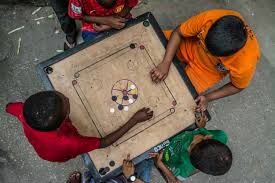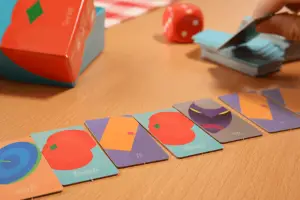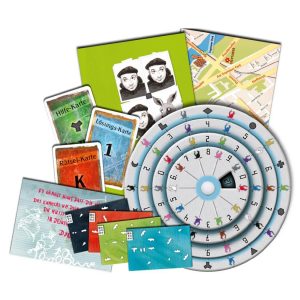When I say ‘board game’, what comes to mind?
If you’re from a western liberal country, you probably thought of Monopoly or Chess. Or else probably Risk or Settlers of Catan.

But what if I told you that other cultures have widely different conceptions of board games?
As in, their board games reveal a different perspective on what it means to play and have fun, a different view on competition and winning and losing, different skills that are appreciated and fostered in their board games, and different ideas of who can join the game.
I hear some critics think: wait, you’re not a part of all these cultures, are you? So how can you know which board games are popular in them?
The way I conducted my scientific research, is as follows. I monitored the Amazon best selling board games page for each country in this list, so amazon.com, amazon.cn, amazon.co.jp, amazon.com.br and amazon.de.
I also used a browser that hides my own location so that the respective Amazon websites can’t bias the best selling board games lists towards my own culture.
So I just checked these lists periodically (because they get updated from time to time) and noted down any board games that were on there often, and that aren’t as popular in US culture.
So, here’s my results:
 Let’s start with an expected result, so that we know the methodology is sound. As we all know, Go is big in China. So, do we see it in their best selling board games list?
Let’s start with an expected result, so that we know the methodology is sound. As we all know, Go is big in China. So, do we see it in their best selling board games list?
Yes! As a matter of fact, whenever I looked, there were at least 3 different editions of Go in the list. I’m not entirely different editions sometimes had different rules, or whether they just differed in size and production quality.
The list was further dominated by Chinese Checkers and other variations of Chess that we don’t play a lot in the west.
This highlights the cultural importance for abstract thinking in China. This is a skill that is greatly appreciated and therefore fostered through their most popular board games.
In particular it also underlines their appreciation for one on one, military commander style tactical battles – a tendency that has remained alive ever since Sun Tzu wrote the art of war during the Chinese warring states period.
 India is interesting. Of course, it’s a huge country and one of the most culturally diverse ones on earth. But, one thing that’s widely recognized is that they are generally more collectivist and place a higher value on the community than the western cultures.
India is interesting. Of course, it’s a huge country and one of the most culturally diverse ones on earth. But, one thing that’s widely recognized is that they are generally more collectivist and place a higher value on the community than the western cultures.
And we can recognize this aspect of their culture in their most popular board games. In their list, I often notices multiple entries of Carrom.
Carrom is something like a combination of shuffleboards and billiards. So it’s more of a physical dexterity kind of game, rather than a thinking game, and I think that already says something. For one thing, Carrom doesn’t require you to be literate, like most western board game do. This is important as many Indians are illiterate, especially in the poorer areas of the country.
Further, Carrom is played by all ages. Children and elderly can also play it together, which plays into the value that India places on the elderly and the community at large.
So in general Carrom is more inclusive than most western games, which fits an environment in which people of different ages and educations live together in greater numbers than in the US.
 Japan is the hardest result for me to explain. I’ll just start with the game that caught my eye.
Japan is the hardest result for me to explain. I’ll just start with the game that caught my eye.
Toma Tomato is a game with four kind of cards. These cards say: tomato, toma, to, or ma. Then players line up a bunch of these cards, and try to say them really fast.
So the line up will be something like ‘to ma toma tomato to to ma tomato toma‘ – and you try to stumble your way through saying that without getting cramps in your tongue.
Soooo, that’s a game…. right?? I don’t really know what cultural conclusions to draw from it. But Tomato Tomato certainly fits my stereotypes of the weird things that Japanese can sometimes inexplicably be into.
And another interesting finding in Japan is Mangara Karaha, which is an Asian style Mancala game. This isn’t specifically Japanese, because Mancala games are actually widely popular in Africa, the Middle East and the rest of Asia as well, and all regions have their own versions of it.
 Brazil’s most popular board game is Bandido. Check out the cover art on that picture. That’s the most hilarious stereotypical Brazilian desert bandit they could have drawn.
Brazil’s most popular board game is Bandido. Check out the cover art on that picture. That’s the most hilarious stereotypical Brazilian desert bandit they could have drawn.
Obviously, Brazil harbors many real life bandidos; their crime rates are much higher than those in the western world. And I think this game is one way to cope with that fact. The game is cooperative, and players together try to keep the bandido from escaping prison. I know it’s just a game, but I think it speaks to the desire of the Brazilians to deal with the crime problem in their country.
Sometimes the number one in the best seller board game list in Brazil, is just a deck of playing cards. My guess is that this is because a lot of Brazilians can’t afford many modern board games, so they buy this cheaper and multi purpose deck of cards instead. I think this speaks to Brazilian resilience and the ability to make do with what you have.
 Germany is of course also a western democracy and culturally it isn’t too different from the US. And to be honest, this last observation isn’t quite cultural, but I still found it interesting.
Germany is of course also a western democracy and culturally it isn’t too different from the US. And to be honest, this last observation isn’t quite cultural, but I still found it interesting.
Germany’s best selling board game list is dominated by EXIT, which is an escape room board game. At any given time, 8 of the top 10 entries might be an edition of EXIT. Why is that?
It turns out, that EXIT is created and produced in Germany, and in German. There are in fact many editions of EXIT that haven’t been translated from German to English yet. So it isn’t necessarily true that Germans like EXIT more than Americans – it might just be that the game is more available in Germany.
Of course, you could still ask whether there’s a cultural reason that the Germans were the ones to invent this game. And there might be, but I’m struggling to come up with it…
An interesting question is whether the popularity of EXIT in Germany is a sign of things to come over here. EXIT is already a pretty popular game in the US, but perhaps the untranslated versions are simply even better. If that’s the case, we might be playing a lot of EXIT is the near future as well.
Conclusion
I think board games have huge cultural significance, and we can learn about cultures by studying the board games they play.
In this short article with case studies, I hope I convinced you of this. And I hope it may broaden your perspective on everything that board games entail: fun, competition, and community.
